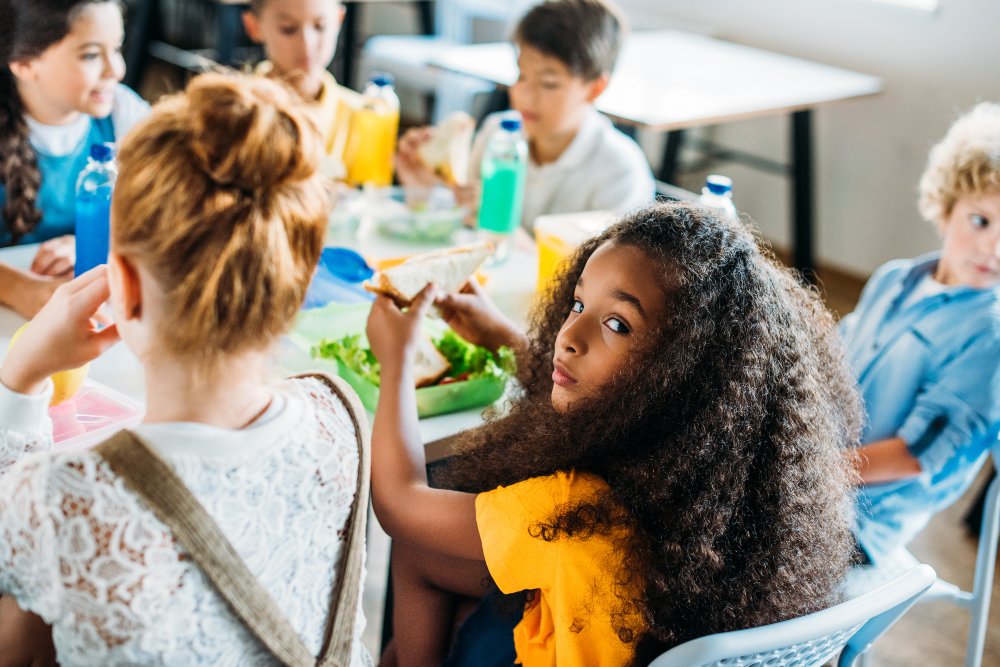
african american schoolgirl taking lunch at school cafeteria with her classmates and looking at
My Image Source: Envato
The school cafeteria is the preferred place by many kids. It is where they get to relax, socialize, acquire acceptable hygienic practices and encourage a good diet. A good number of school cafeterias assign kids seating tables. While some kids think this is fun, some enjoy assembling with their friends. Assigned cafeteria seating does impact the attitude and mood of kids now and then. Here are ten reasons why your school cafeteria matters.
Impacts the social life of kids
Some schools have embraced an arranged cafeteria seating. Kids spend their lunch breaks sharing and catching up with their friends. The arranged seating limits kid’s interactions. They must sit precisely where the cafeteria administrator asks them to sit, which leaves them to interact with a smaller circle of other kids. In the case the kids are in an open seating plan, they can interact with different kids at every lunch break, make more friends, and form influential groups.
Conflict of interest
If a school has arranged cafeteria seating, it may trigger arguments among the kids. The kids will quarrel over sitting positions. Some kids may want to sit next to their chosen friends, while others want to sit at a favorite spot. Gradually it may result in fights among the kids. The conflict of interest may lead to cases of bullying among kids who share a table.
Constrained creativity
When kids are mandated to sit only in a certain way, they grow to apprehend existing guidelines and rules, which may lower their desire to be creative or have faith in their opinions and thoughts. When kids are allowed to make their own choices, they begin to embrace the freedom of thought.
Analytical reasoning may impact how they associate with real-life difficulties as they grow up. Critical thinking promotes creativity and innovation among kids, stimulating their thought and pushing them to improve their problem-solving techniques.
Improves hygienic practices
When a school has open seating where the kids can sit where they want, it raises their responsibility level. They begin to take ownership of any mess created around where they sit, and they will look out to ensure they leave their eating station clean. If the kids sit where the administration intends them to sit, they may eat carelessly and leave their eating station in a mess.
Freedom of choice
Some schools allow their kids to choose who and where to sit during mealtime. Seating together allows the kids to catch up with friends and remind them of an important life lesson of choice. It is a reminder to kids that they can choose what they want and that it is not mandatory to take any negative remarks from others.
Changes in appetite
Some kids just get inspired to eat because they enjoy the company they get from their friends. When the seating plan is precise, they may lose food appetite, impacting their sports and class energy. When the kids do not feed well, the long term effect is almost unavoidable; infections and diseases may challenge their immunity, which may cause them to miss classes.
Personality development
Kids who sit as ordered may end up isolating themselves because they are frightened to mingle with the rest of the kids with whom they share the school cafeteria tables. Different kids have different personalities, and it is essential to support kids through personality development using more dependable approaches.
Equity
Kids want to feel entitled to even opportunities. Some kids may feel different when their classmates coincidentally sit with their friends in an arranged cafeteria seating. In some cases, an arranged cafeteria may help reduce social class biases and categorization.
Emotional stability
It is helpful to kids to share lunch with their friends with whom they can be vulnerable. Such a vulnerability level boosts their self-esteem and confidence, unlike being compelled to sit with other kids.
Time management
In some cases, where students have an arranged cafeteria, they finish their lunch quite fast, unlike when they are close to their friends where they eat while catching up with their friends. On the other hand, an open cafeteria may give kids lessons on being time conscious from an early age.
There are other cases where arranged seating has improved several schools’ culture on inclusivity by ensuring that no kid eats lunch alone. If you use either an arranged or open cafeteria, it is crucial to prioritize the children’s development and hold tremendous interest in enjoying time at the cafeteria.


